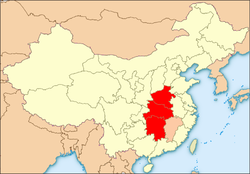Geographic region of China



| This article needs additional citations for verification. Please help improve this article by adding citations to reliable sources. Unsourced material may be challenged and removed. Find sources: "Central China" – news · newspapers · books · scholar · JSTOR (January 2023) (Learn how and when to remove this message) |
Central China (Chinese: 华中; pinyin: Huázhōng) is a region in China. It mainly includes the provinces of Henan, Hubei and Hunan. Jiangxi is sometimes also regarded to be part of this region. Central China is now officially part of the South Central China region.
In the context of the Rise of Central China Plan by the State Council of the People's Republic of China in 2004, surrounding provinces including Shanxi, Anhui, are also defined as regions of Central China development zones.
Since 2004, these provinces have experienced a steady increase in domestic investment, particularly from coastal regions.
As part of the Xi Jinping administration's goal to urbanize 250 million citizens by 2025 as the first phase of a long-term green modernization plan, China seeks to resettle formerly rural people in provincial capitals, prefectural cities, and county-level towns in central China (as well as western China).
Administrative divisions
| GB | ISO № | Province | Chinese Name | Capital | Population | Density |
Area |
Abbreviation/Symbol | |
|---|---|---|---|---|---|---|---|---|---|
| Yù | 41 | Henan Province | 河南省 Hénán Shěng |
Zhengzhou | 94,023,567 | 563.01 | 167,000 | HA | 豫 |
| È | 42 | Hubei Province | 湖北省 Húběi Shěng |
Wuhan | 57,237,740 | 307.89 | 185,900 | HB | 鄂 |
| Xiāng | 43 | Hunan Province | 湖南省 Húnán Shěng |
Changsha | 65,683,722 | 312.77 | 210,000 | HN | 湘 |
Cities with urban area over one million in population
Provincial capitals in bold.
| # | City | Urban area | District area | City proper | Prov. | Census date |
|---|---|---|---|---|---|---|
| 1 | Wuhan | 7,541,527 | 9,785,388 | 9,785,388 | HB | 2010-11-01 |
| 2 | Zhengzhou | 3,677,032 | 4,253,913 | 8,627,089 | HA | 2010-11-01 |
| 3 | Changsha | 2,963,218 | 3,092,213 | 7,040,952 | HN | 2010-11-01 |
| 4 | Luoyang | 1,584,463 | 1,926,079 | 6,549,941 | HA | 2010-11-01 |
| 5 | Xiangfan | 1,433,057 | 2,199,690 | 5,500,307 | HB | 2010-11-01 |
| 6 | Hengyang | 1,115,645 | 1,133,967 | 7,148,344 | HN | 2010-11-01 |
| 7 | Yichang | 1,049,363 | 1,411,380 | 4,059,686 | HB | 2010-11-01 |
See also
Notes
- Xiangfan was renamed as Xiangyang on 2 December 2010.
References
Citations
- ^ Ang, Yuen Yuen (2016). How China Escaped the Poverty Trap. Cornell University Press. ISBN 978-1-5017-0020-0. JSTOR 10.7591/j.ctt1zgwm1j.
- Rodenbiker, Jesse (2023). Ecological States: Politics of Science and Nature in Urbanizing China. Environments of East Asia. Ithaca, NY: Cornell University Press. ISBN 978-1-5017-6900-9.
- GB/T 2260 codes for the provinces of China
- ISO 3166-2:CN (ISO 3166-2 codes for the provinces of China)
- ^ 国务院人口普查办公室、国家统计局人口和社会科技统计司编 (2012). 中国2010年人口普查分县资料. Beijing: 中国统计出版社 . ISBN 978-7-5037-6659-6.
Sources
Categories: